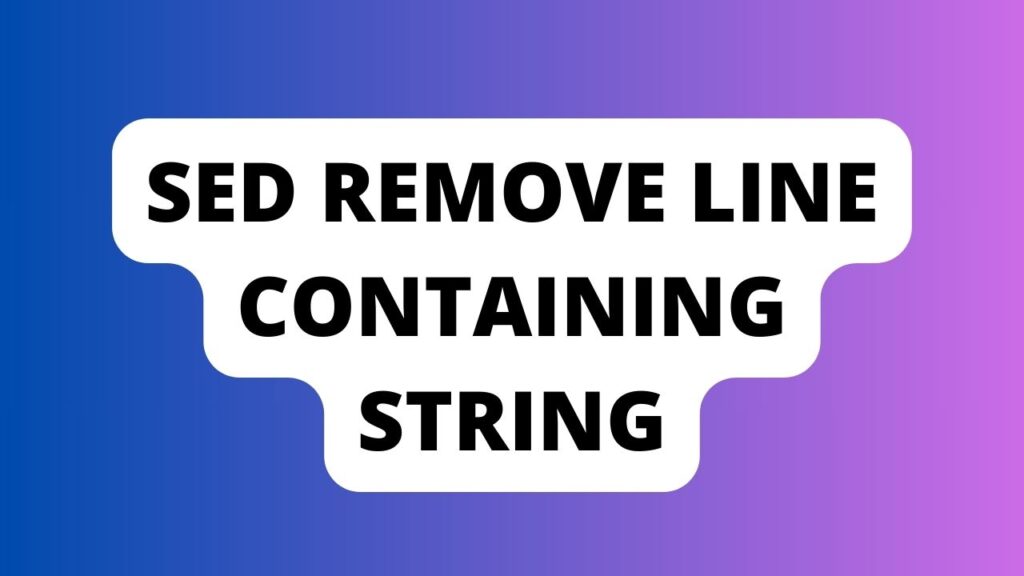Introduction
Sed Remove Line Containing String The sed command, short for “stream editor,” allows users to perform various text manipulation tasks, including removing lines that contain specific strings. Understanding its functionalities and syntax is pivotal in harnessing its prowess effectively.
What is the use of sed command?
sed primarily serves as a text stream editor in Unix-like operating systems. It processes input line by line, enabling modifications like search, substitution, deletion, and insertion.
Basics of finding and replacing text in sed
Before diving into removing lines, comprehending the basics of finding and replacing text within sed is essential. The command structure involves patterns, actions, and options to execute specific tasks.
Understanding sed
Exploring the core functions and standard commands of sed lays the groundwork for efficiently removing lines based on specific criteria.
Key functions of sed
The primary functions of sed encompass text substitution, deletion, appending, and printing specific lines or ranges within a file.
Common sed commands
Commands like s/old/new/ for substitution or d for deletion are frequently employed in sed operations.
Syntax of sed
Understanding the anatomy of a sed command and the usage of flags and options amplifies precision in text manipulation.
Anatomy of a sed command
A typical sed command consists of an address or range, a command, and options, all contributing to the targeted modification.
Usage of flags and options
Flags like -n for silent mode or -i for in-place editing, coupled with various options, extend the functionality of sed commands.
Removing Lines
The core focus of using sed—the removal of lines containing specific strings—demands attention to nuances and techniques.
How sed removes lines
The process involves identifying lines based on a given pattern and subsequently deleting or modifying them.
Removing lines with a specific string
Executing sed commands with specified strings enables the deletion of lines matching those exact patterns.

Techniques
Delving deeper into techniques empowers users to perform nuanced line removals based on varying conditions.
Deleting lines using patterns
Utilizing patterns, such as regular expressions, widens the scope of line removal, allowing for versatile text manipulations.
Deleting lines with specific content
sed facilitates the removal of lines not just with exact matches but also with content containing specific phrases or characters.
Advanced Options
Mastering advanced options in sed unveils its full potential in handling complex line removal scenarios.
Addressing specific lines
sed allows users to address specific lines based on line numbers, ranges, or conditions, streamlining precise modifications.
Removing multiple occurrences
Efficiently removing multiple occurrences of lines containing specific strings involves leveraging sed with appropriate modifiers.
Best Practices
Navigating the realm of sed line removals demands adherence to best practices for seamless and secure operations.
Efficiency tips for sed
Optimizing command structures and leveraging appropriate options enhances the efficiency of sed operations.
Safety measures when removing lines
Implementing precautions like backups or dry runs before executing sed commands mitigates the risk of unintended data loss.
Understanding Sed
To effectively employ the Sed Remove Line Containing String technique, grasping the fundamentals of Sed is essential.
Basics of Sed
Sed, short for Stream Editor, is a powerful command-line tool used for parsing and transforming text. Its functionality revolves around processing streams of text line-by-line.
Functionality of Sed in Text Manipulation
Sed offers a range of functions, allowing users to perform tasks like search, find and replace, delete lines, insert text, and more, making it a versatile tool for text manipulation.
FAQs
Addressing common queries regarding sed line removal enriches the reader’s understanding and troubleshooting capabilities.
- Can
sedremove multiple lines? - Is
sedcase-sensitive when removing lines? - How to use
sedto remove lines recursively? - What happens if the line contains special characters?
- Can
seddelete lines using regular expressions? - How does one undo a line removal using
sed?
Conclusion
In conclusion, mastering the art of removing lines with sed empowers users to manipulate text efficiently. Understanding its intricacies, employing diverse techniques, and following best practices ensure a seamless text editing experience.
